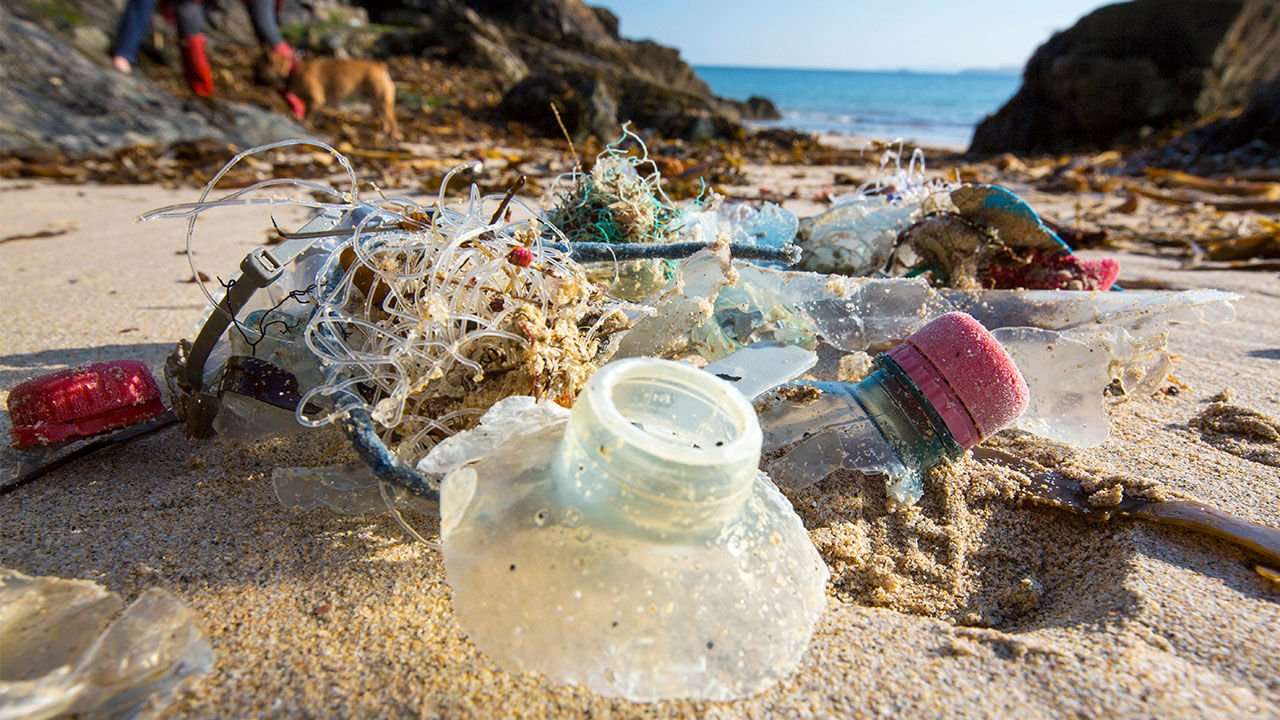These tiny microbes are munching away at plastic waste in the ocean
Plastic makes up nearly 70% of all ocean litter, putting countless aquatic species at risk. But there is a tiny bit of hope—a teeny, tiny one to be precise: Scientists have discovered that microscopic marine microbes are eating away at the plastic, causing trash to slowly break down.
To conduct the study, researchers collected weathered plastic from two different beaches in Chania, Greece. The litter had already been exposed to the sun and undergone chemical changes that caused it to become more brittle, all of which needs to happen before the microbes start to munch on the plastic. The pieces were either polyethylene, the most popular plastic and the one found in products such as grocery bags and shampoo bottles, or polystyrene, a hard plastic found in food packaging and electronics. The team immersed both in saltwater with either naturally occurring ocean microbes or engineered microbes that were enhanced with carbon-eating microbe strains and could survive solely off of the carbon in plastic. Scientists then analyzed changes in the materials over a period of 5 months.

Hotomato on May 21st, 2019 at 13:15 UTC »
Dumb question but are the huge swaths of garbage floating around in the ocean I keep seeing videos of all litter? I just find myself constantly asking “how the the hell does all this trash get into the ocean?”.
Epyon214 on May 21st, 2019 at 11:41 UTC »
Breaking down into what? What is the byproduct? What waste as these microbes excreting as a result of this?
mvea on May 21st, 2019 at 10:39 UTC »
The title of the post is a copy and paste from the first and third paragraphs of the linked academic press release here:
Journal Reference:
Evdokia Syranidou, Katerina Karkanorachaki, Filippo Amorotti, Apostolos Avgeropoulos, Boris Kolvenbach, Ning-Yi Zhou, Fabio Fava, Philippe F.-X. Corvini, Nicolas Kalogerakis,
Biodegradation of mixture of plastic films by tailored marine consortia,
Journal of Hazardous Materials, Volume 375, 2019, Pages 33-42, ISSN 0304-3894,
DOI: https://doi.org/10.1016/j.jhazmat.2019.04.078.
Link: http://www.sciencedirect.com/science/article/pii/S0304389419305060
Highlights
• Biodegradation of mixtures of waste plastic comprising of weathered PE & PS films has been accomplished successfully.
• Significant weight loss was observed.
• Waste plastics harbor distinct microbial communities (composition and functional profile) compared to planktonic counterpart.
Abstract:
This work sheds light on the physicochemical changes of naturally weathered polymer surfaces along with changes of polymer buoyancy due to biofilm formation and degradation processes. To support the degradation hypothesis, a microcosm experiment was conducted where a mixture of naturally weathered plastic pieces was incubated with an indigenous pelagic community. A series of analyses were employed in order to describe the alteration of the physicochemical characteristics of the polymer (FTIR, SEC and GPC, sinking velocity) as well as the biofilm community (NGS). At the end of phase II, the fraction of double bonds in the surface of microbially treated PE films increased while changes were also observed in the profile of the PS films. The molecular weight of PE pieces increased with incubation time reaching the molecular weight of the virgin pieces (230,000 g mol−1) at month 5 but the buoyancy displayed no difference throughout the experimental period. The number-average molecular weight of PS pieces decreased (33% and 27% in INDG and BIOG treatment respectively), implying chain scission; accelerated (by more than 30%) sinking velocities compared to the initial weathered pieces were also measured for PS films with biofilm on their surface. The orders Rhodobacterales, Oceanospirillales and Burkholderiales dominated the distinct platisphere communities and the genera Bacillus and Pseudonocardia discriminate these assemblages from the planktonic counterpart. The functional analysis predicts overrepresentation of adhesive cells carrying xenobiotic and hydrocarbon degradation genes. Taking these into account, we can suggest that tailored marine consortia have the ability to thrive in the presence of mixtures of plastics and participate in their degradation.